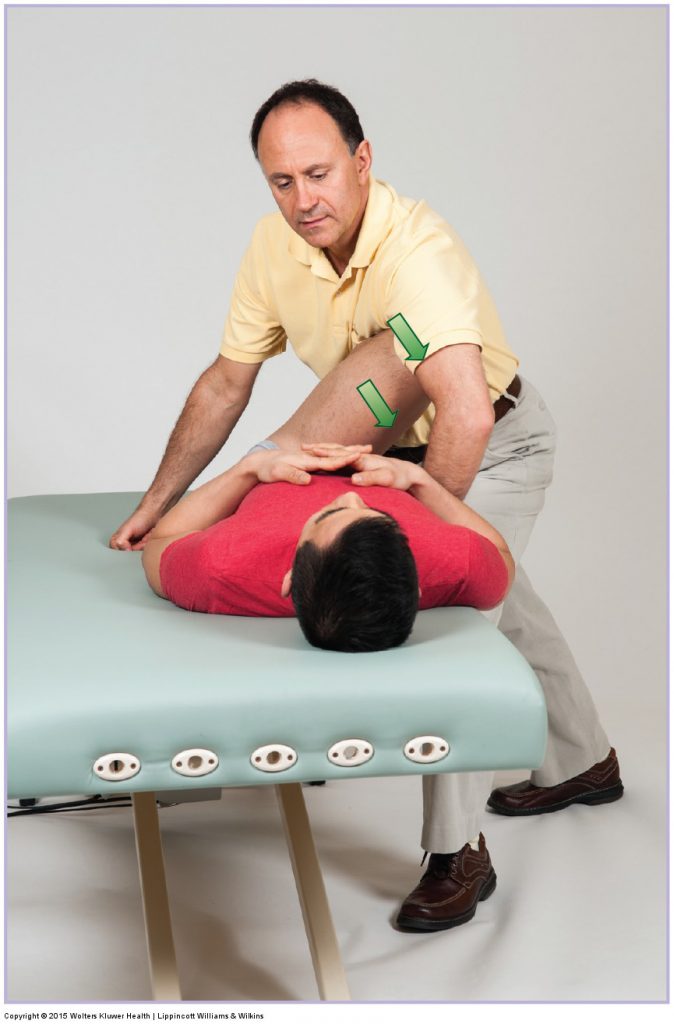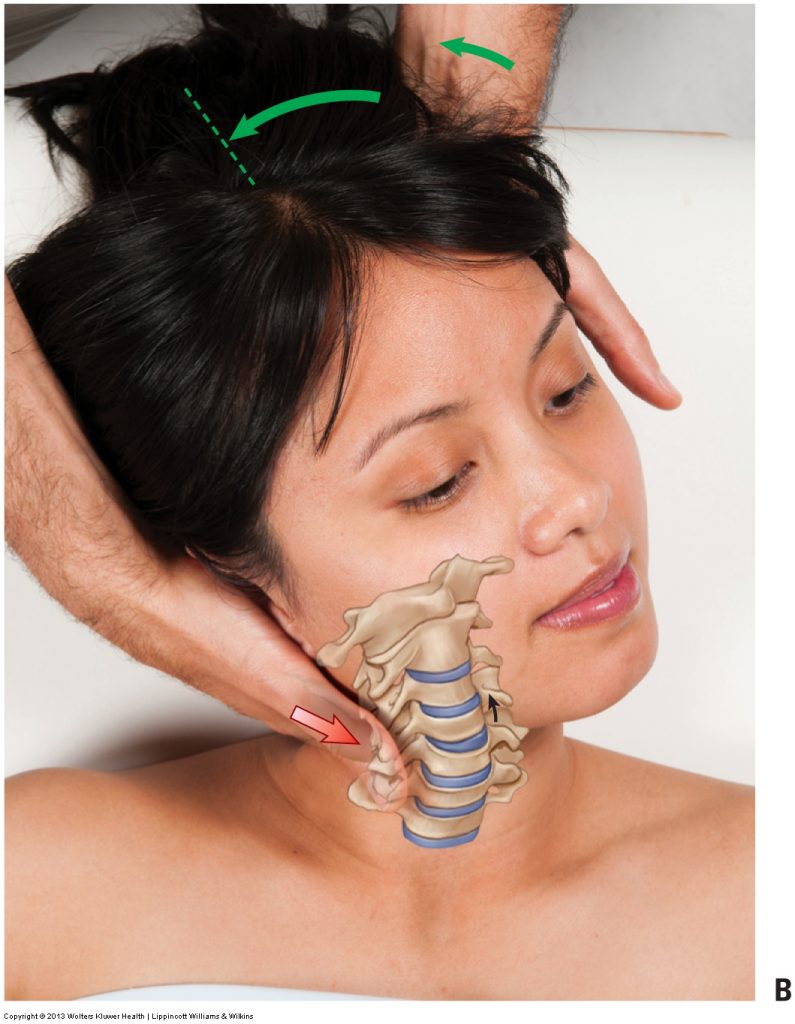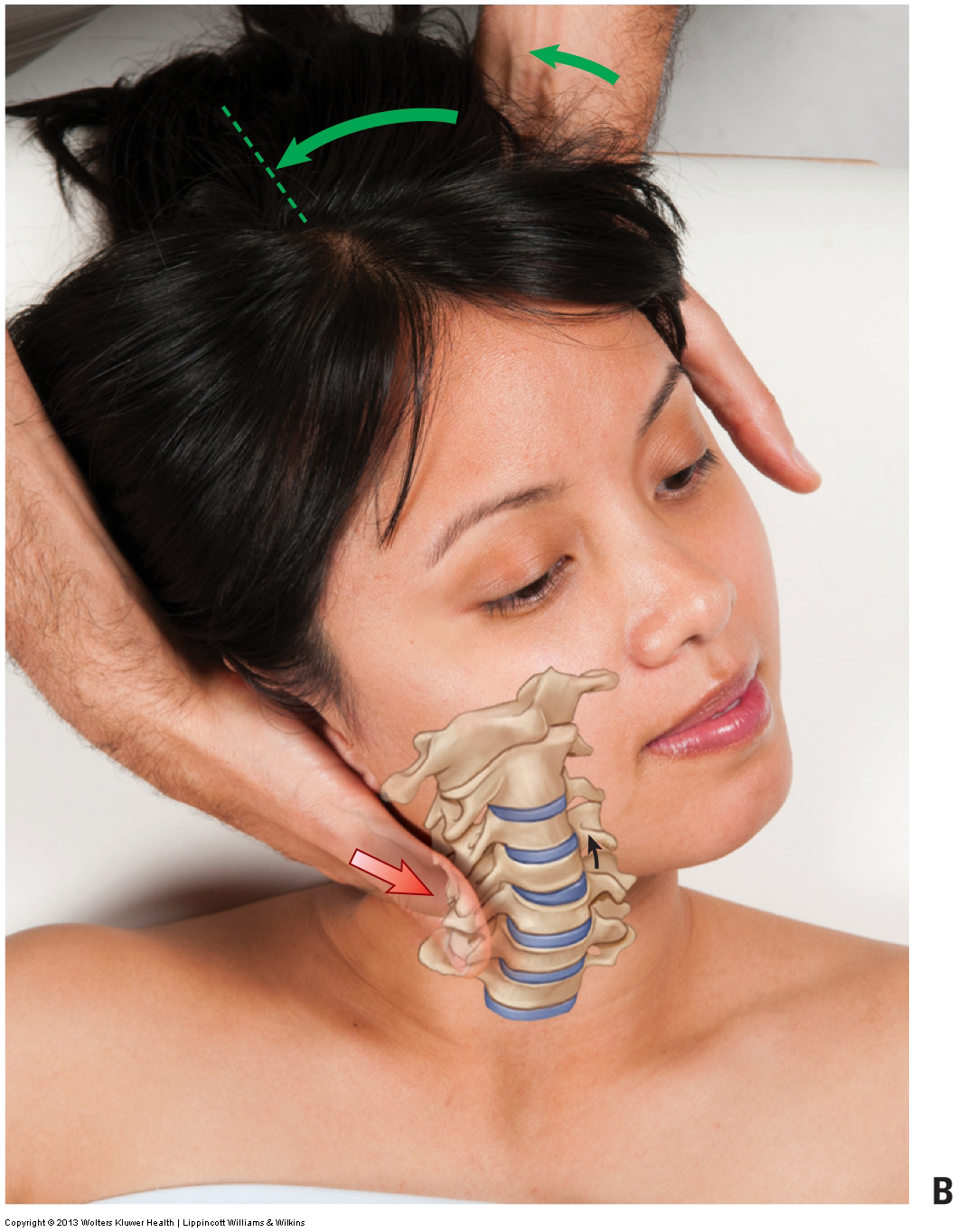Fundamental Manual Therapy Skills

Massage therapy to the neck. Permission Joseph E. Muscolino. Advanced Treatment Techniques for the Manual Therapist – Neck (2012).
The value of massage therapy continuing education is often dependent on learning how to apply fundamental skill sets of manual therapy. If I were to distill effective clinical orthopedic manual therapy (COMT) to its fundamental essentials, I believe that the four essential tools when working on a client/patient are heat, massage therapy, stretching, and joint mobilization (whether it is Grade IV of Grade V).
Although each modality in and of itself is wonderful, I feel that the combination of these modalities is far greater than the sum of the parts. When performed together in one treatment session, I feel that each one works off the other to create an extremely effective session.
For the massage therapist, learning some of these skills is a part of core curriculum. But learning others is often done as a part of continuing education. This blog post article is meant to explore these fundamental treatment skill sets so the massage therapist is better informed about their massage therapy continuing education needs.
What Is the Purpose of Manual Therapy?
This is a big question and can be answered on many different levels. However, if we are to take a step back and answer with the most common big-picture reason that manual therapy is done, I would say that it is the make taut/tight soft tissues looser, in other words more flexible. This would include loosening tight musculature (which can be described as inhibiting muscle tone) and decreasing fascial adhesions (as well as fascial contraction).
Heat
When it comes to making taut/tight soft tissues more flexible, I strongly believe that heat is an essential component of the treatment plan. Heat is a central nervous system (CNS) depressant (down regulates the CNS) to relax musculature and also mechanically makes soft tissue softer and more pliable. For this reason, I like to precede stretching and joint mobilization with heat, especially moist heat. Note: I believe that using a hydrocollator machine is the easiest and more efficient way to utilize moist heat in practice.
Massage Therapy
Massage therapy (soft tissue manipulation) is a relative newcomer to the recognized and respected manual therapy modalities. Certainly, massage therapy itself (soft tissue manipulation) is the most key skill set for massage therapy continuing education.
More and more research is coming out every year that demonstrates the effectiveness of massage therapy. Although I am not sure that I feel that these research studies need to be done to believe in the power of massage therapy, it is always good to have evidence-based research to back up and reproduce the results that we have been seeing in our offices for years/decades. Although we could fill a book with the possible mechanisms of beneficial effects of massage therapy, it seems clear from looking at fundamental physical and neural mechanics that massage therapy works on the mechanical level of manipulation of myofascial tissue, as well as moving arterial/venous/lymph fluid, as well as working with sensory feedback into the CNS for neural effects. And this is beyond the wonderful effects of touch generally. For these reasons, I also regularly incorporate massage therapy into the treatment regimen for any region of the client’s body that I am treating. As with heat, I usually include massage therapy before I utilize stretching and joint mobilization.
Stretching

Stretching the deep lateral rotators of the hip. Permission Joseph E. Muscolino. Manual Therapy for the Low Back and Pelvis – A Clinical Orthopedic Approach (2013).
Stretching has become a controversial subject in recent years, but I do not see how the fundamental concept of stretching can be doubted. Soft tissues are adaptable and will change based on forces placed on them. For example, the fundamental characteristic of soft tissue known as “creep” states that a soft tissue will deform based on a sustained force placed on it. Unless this principle of soft tissue is refuted, stretching, and specifically static stretching that involves a sustained force, must have benefit. And every study I have ever seen that examines stretching as part of one’s continuing lifestyle buttresses the fact that stretching is effective at making soft tissues longer / more flexible. Dynamic stretching that involves repetitive stretching positions that are not held for sustained periods of time (dynamic stretching positions are usually held for five second or fewer), seems an ideal way to warm up tissue.
Both static and dynamic stretching, which are essentially mechanical treatments, can have pin and stretch technique added. This allows us to focus a stretch to a specific region (end) of a muscle. And then we have neural inhibition stretching techniques that take advantage of neural reflexes that inhibit (relax) muscle tone. These reflexes are reciprocal inhibition and the Golgi tendon organ (GTO) reflex (there is some controversy of late as to the role of the GTO reflex). The stretching techniques that utilize these neural reflexes read like a list of alphabet soup names: CR (contract relax), PIR (post isometric relaxation), AC (agonist contract), PNF (proprioceptive neuromuscular relaxation), MET (muscle energy technique), etc.
There are many choices for massage therapy continuing education when it comes to stretching. Hopefully, the foregoing discussion clears up the concept of stretching.
Digital COMT
Did you know that Digital COMT (Digital Clinical Orthopedic Manual Therapy), Dr. Joe Muscolino’s continuing education video streaming subscription service for massage therapists (and all manual therapists and movement professionals), has at present (September of 2018) more than 1,000 video lessons on manual therapy continuing education, including entire folders on massage therapy, stretching, and joint mobilization. And we add seven (7) new videos lessons each and every week! And nothing ever goes away. There are also folders on Pathomechanics and Anatomy and Physiology, including an entire folder on Cadaver Anatomy… and many, many more on other manual and movement therapy assessment and treatment techniques? Click here for more information.
Joint Mobilization

Grade IV joint mobilization to the neck. Permission Joseph E. Muscolino. Advanced Treatment Techniques for the Manual Therapist – Neck (2012).
The most advanced manual therapy skill set that exists for massage therapists is joint mobilization. This is certainly a modality that must be found in the world of massage therapy continuing education.
Joint mobilization is an incredibly important part of a manual therapy session. Unfortunately, most massage therapists do not learn to perform joint mobilization treatment. To me, this is a pity because I do not see how true healing of most musculoskeletal (neuro-myo-fascio-skeletal) conditions can ever occur if the joint component is not addressed and remedied. It is a like the proverbial chicken and egg. Restricted (hypomobile) joints due to tautness of the intrinsic fascial tissue (ligament joint capsule complex) and taut/tight extrinsic myofascial tissue are inextricably linked. If extrinsic myofascial tissue are loosened with heat, massage and stretching, but the joints remain restricted, then the extrinsic soft tissues will likely tighten up again. And of the joint is released / loosened by “stretching the intrinsic fascial tissue, but the extrinsic myofascial tissue remains taut, then the joint will not be able to maintain its increased range of motion and will likely become restricted (hypomobile) again. Both must be addressed.
Intrinsic Joint Fascia
It should be emphasized that massage therapists are not just “muscle therapists,” but are “myofascial therapists.” And as myofascial therapists, fascia is of primary concern to the field of massage therapy (and manual therapy more generally). If massage therapists are happy to treat myofascial tissue, and subcutaneous fascial tissue, and abdominal visceral fascial tissue, why would intrinsic fascial tissue of a joint be excluded?
Joint Mobilization IS Stretching
To use the term “joint mobilization” intimidates many massage therapists. Indeed, this skill is usually never taught in core curriculum massage school, and massage therapists are often told in school to stay away from the joints. As a result, this treatment skill must be learned in continuing education formats. Certainly, this skill is a more advanced skill and has the power to help the client and similarly has the power to harm the client if not practiced effectively and safely. But mobilizing a joint is actually a form of soft tissue stretching. It is effectively a specific form of soft tissue stretching known as pin and stretch. In the case of joint mobilization, pin and stretch technique involves one bone being pinned while the adjacent bone is moved away from it, stretching the soft tissue located between the two bones (the intrinsic fascial tissue joint capsule and ligaments).
Because so many massage therapists are hesitant to learn joint mobilization in massage therapy continuing education classes, I try to make this skill set less intimidating for therapists by emphasizing that joint mobilization IS stretching.
Grade IV versus Grade V Joint Mobilization
The essential difference between Grade IV joint mobilization and Grade V joint mobilization is that Grade IV utilizes slow oscillations while Grade V utilizes a fast thrust. It should be emphasized that although Grade IV is legal and ethical for most all massage therapists in the United States (please check with your state or certifying body to be sure that it is within the scope of your practice), a fast thrust Grade V mobilization (often referred to as a chiropractic manipulation or adjustment) is never legal or ethical for a massage therapist.
Order of Treatment Modalities
Although cook book routines should always be avoided, and the application of our treatment techniques should always be determined by the response of the tissues of the client on the table at the moment, it is helpful to formulate default guidelines for the order of treatment modalities when performing clinical orthopedic manual therapy (COMT). As a guideline, I recommend heat and massage are first applied to the region being worked. Stretching and joint mobilization are then applied after the heat and massage. Regarding stretching and joint mobilization, whether it is stretching or joint mobilization that is applied first will depend on the client.
But thinking of heat and stretching done first, followed by stretching and joint mobilization stretching done second is a good way to begin. Then we adjust the order of modalities as appropriate for the client.
Note about Cook Book Routines
A good friend of mine, and an excellent massage therapist, once said to me that most massage therapy continuing education techniques that are taught are proprietary techniques that simply take fundamental skill sets and place them into a sequence and then place a fancy name on it. In this regard, the ordered sequence very often becomes a dogmatic cook book formula, which I strongly advocated against. For any technique to stay present in the field of massage therapy, there must be value in it. Having said that, if any technique has been around for a while and we are not ALL doing it, it must mean that it does not cure everyone of everything.
So… I believe the value lies in attending as many massage therapy continuing education workshops as possible and learning as many skill sets as possible, and placing them into your proverbial tool box of skills. Then when a client comes in with a particular condition (or more likely conditions), you can critically think through the mechanism of the condition and creatively apply your skill set tools!
Massage Therapy Continuing Education
Certainly, if a new skill is to be applied by a massage therapist, it is extremely important for the therapist to seek continuing education to learn this skill. Given that manual therapy is a kinesthetic profession, in-person continuing education workshops is always the most important way to learn a new manual therapy skill, whether it is a new massage therapy or stretching skill, and especially if it is joint mobilization skill. However, given the challenge of finding in-person continuing education workshops in the topic of your interest, and locally in your region, on-line video instruction education is the next best thing. And certainly, written instruction found in textbooks and articles is also valuable.
Following are some excellent resources for learning continuing education manual therapy skills:
Joseph E. Muscolino – Clinical Orthopedic Manual Therapy (COMT) workshops
Dr. Joe Muscolino offers many in-person COMT courses, including three different full COMT Certifications.
Integrative Mastery Approach – Level 2
Click here for Dr. Joe’s workshop schedule.
Digital COMT
Dr. Joe Muscolino also offers a continuing education video streaming subscription service for manual therapists and movement professionals called Digital COMT. As of this moment, Digital COMT has more than 1,000 video lessons. And seven (7) new lessons are added each and every week (and nothing ever goes away). Digital COMT also offers full workshops as well as over 175 hours of free continuing education credits from the national Certification Board for Therapeutic Massage the Bodywork / NCBTMB for subscribers.
Click here to learn more about Digital COMT.
Whitney Lowe
Whitney primarily offers continuing education for assessment, not treatment, but his content is excellent.
Click here to learn more about Whitney’s massage therapy continuing education.
Tom Myers
Tom Myers of Anatomy Trains fame is an excellent resource for continuing education for manual and movement therapists.
Click here to learn more about Tom’s massage therapy continuing education.
Erik Dalton
Erik, and the instructors who teach for him, are another excellent resource for manual therapy that is oriented toward clinical orthopedic work.
Click here to learn more about Erik’s massage therapy continuing education.
There are many other excellent continuing education instructors in the world of clinical orthopedic work for massage therapy. I have simply provided some of the more well-known individuals.
NCBTMB
When in doubt about your massage therapy continuing education needs, check out the NCBTMB (National Certification Board for Therapeutic Massage the Bodywork) website for NCB Approved Providers.
(Click here for the blog post article: Manual Therapy Certification for Massage Therapists.)


